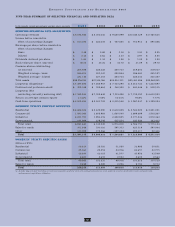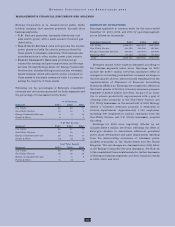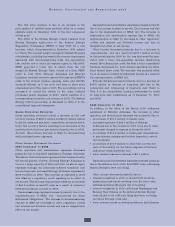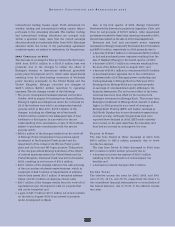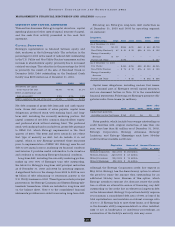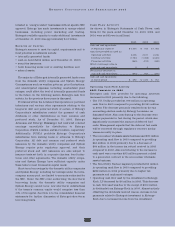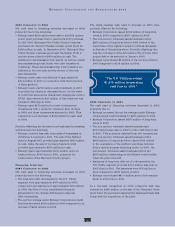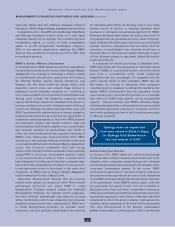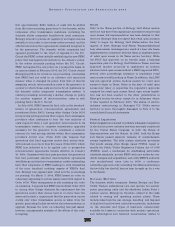Entergy 2003 Annual Report Download - page 34
Download and view the complete annual report
Please find page 34 of the 2003 Entergy annual report below. You can navigate through the pages in the report by either clicking on the pages listed below, or by using the keyword search tool below to find specific information within the annual report.
32
ENTERGY CORPORATION AND SUBSIDIARIES 2003
Partially offsetting the decrease was an increase due to the
parent company providing $209 million in operating cash
flow in 2003 compared to using $439 million in 2002 prima-
rily due to the payment that Entergy Corporation made to
Entergy Louisiana in 2002 pursuant to the tax accounting
election made by Entergy Louisiana that is discussed below.
2002 COMPARED TO 2001
Entergy’s cash flow provided by operating activities
decreased in 2002 primarily due to:
The U.S. Utility provided $2,341 million in operating cash
flow, an increase of $693 million compared to 2001. The
increase primarily resulted from the tax accounting elec-
tion made by Entergy Louisiana that is discussed below.
The parent company used $439 million in operating
cash flow compared to providing $407 million in 2001.
The decrease primarily resulted from the payment
that Entergy Corporation made to Entergy Louisiana
pursuant to the tax accounting election made by
Entergy Louisiana that is discussed below.
The Non-Utility Nuclear business provided $282 million
in operating cash flow, an increase of $18 million
compared to 2001.
Entergy’s investment in Entergy-Koch used $47 million
in operating cash flow in 2002, a decrease of $8 million
compared to 2001. The use of cash primarily relates to
tax payments on Entergy’s share of the partnership
income. Entergy did not receive a dividend from
Entergy-Koch in 2002 or in 2001 because the joint
venture was retaining capital for business opportunities.
The non-nuclear wholesale assets business provided
$43 million in operating cash flow in 2002, compared
to using $73 million in 2001.
TAX ELECTION
In 2001 Entergy Louisiana changed its method of accounting
for tax purposes related to the contract to purchase power
from the Vidalia project (the contract is discussed in Note 9
to the consolidated financial statements). The new tax
accounting method has provided a cumulative cash flow
benefit of approximately $805 million through 2003, which
is expected to reverse in the years 2005 through 2031.
The election did not reduce book income tax expense. The
timing of the reversal of this benefit depends on several
variables, including the price of power. Approximately half
of the consolidated cash flow benefit of the election occurred
in 2001 and the remainder occurred in 2002. In accordance
with Entergy’s intercompany tax allocation agreement, the
cash flow benefit for Entergy Louisiana occurred in the
fourth quarter of 2002.
In a September 2002 settlement of a Louisiana Public
Service Commission (LPSC) proceeding that concerned the
Vidalia contract, the LPSC approved Entergy Louisiana’s
proposed treatment of the regulatory impact of the tax
accounting election. In general, the settlement permits
Entergy Louisiana to keep a portion of the tax benefit in
exchange for bearing the risk associated with sustaining
the tax treatment. The LPSC settlement divided the term of
the Vidalia contract into two segments: 2002-2012 and
2013-2031. During the first eight years of the 2002-2012
segment, Entergy Louisiana agreed to credit rates by flowing
through its fuel adjustment calculation $11 million each
year, beginning monthly in October 2002. Entergy
Louisiana must credit rates in this way and by this amount
even if Entergy Louisiana is unable to sustain the tax
deduction. Entergy Louisiana also must credit rates by
$11 million each year for an additional two years unless
either the tax accounting method elected is retroactively
repealed or the Internal Revenue Service denies the entire
deduction related to the tax accounting method. Entergy
Louisiana agreed to credit ratepayers additional amounts
unless the tax accounting election is not sustained if it is
challenged. During 2013-2031, Entergy Louisiana and its
ratepayers would share the remaining benefits of this tax
accounting election.
Investing Activities
2003 COMPARED TO 2002
Net cash used in investing activities increased in 2003
primarily due to the following:
The non-nuclear wholesale assets business realized
$215 million in net proceeds from sales of businesses
in 2002.
Temporary investments of $150 million matured in
2002, which provided cash flow in 2002.
Temporary investments of $50 million were made in
2003, which used cash flow in 2003.
Entergy Gulf States has $77 million and Entergy
Mississippi has $73 million of other regulatory invest-
ments in 2003 as a result of fuel cost under-recoveries.
See Note 1 to the consolidated financial statements for
discussion of the accounting treatment of these fuel cost
under-recoveries. See Note 2 to the consolidated financial
statements for discussion of the change in Entergy
Mississippi’s energy cost recovery rider.
Partially offsetting these uses of cash, approximately
$172 million of the cash collateral for a letter of credit that
secures the installment obligations owed to New York
Power Authority (NYPA) for the acquisition of the
FitzPatrick and Indian Point 3 nuclear power plants was
released to Entergy during 2003. There is approximately
$60 million of cash collateral remaining that Entergy
expects to be released in March 2004 as a result of the
regularly scheduled payment on the note payable to NYPA.
MANAGEMENT’S FINANCIAL DISCUSSION AND ANALYSIS
continued


